Last updated: April 23, 2021
Article
Battle of Sullivan's Island
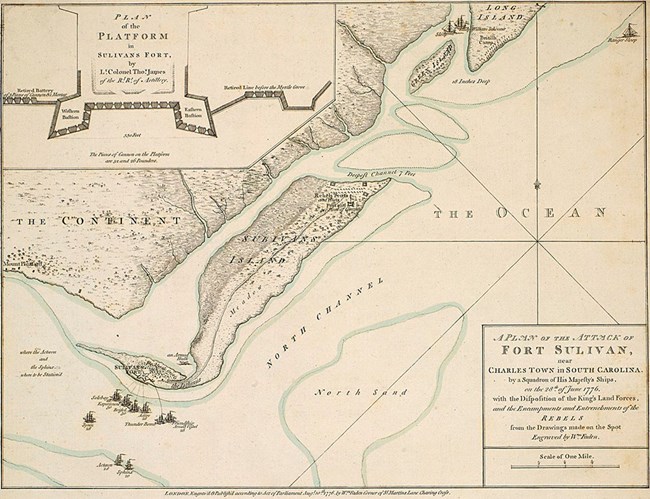
Royal Collection Trust
The Battle of Sullivan's Island, the first decisive patriot victory over the British Royal Navy, shocked the world and protected Charleston during a critical early stage of the American Revolution.
British Southern Expedition
British General Henry Clinton sailed south from Boston in January 1776 with a small force to rendezvous off the Cape Fear River in North Carolina with Lord Charles Cornwallis, who sailed with seven regiments under the protection of Commodore Sir Peter Parker's squadron from Cork, Ireland. The British commander-in-chief General William Howe gave Clinton command of the southern district to "support the Loyalists and restore the authority of the King's government." Afterwards, Clinton and the combined force were to sail north and rendezvous with Howe for the summer campaign against General George Washington's army in New York. Upon their meeting at Cape Fear in February 1776, Clinton and Cornwallis learned of the defeat of Loyalists at the Battle of Moores Creek Bridge. Stymied in North Carolina, the invasion fleet anchored off Cape Fear while Clinton and Parker debated what to do next. While Clinton favored a move up to the Chesapeake, Parker favored Charleston. Clinton wrote that
"Sir Peter Parker having in the mean time procured Intelligence from whence it appeared the Rebel Work on Sullivans Island (the Key to Rebellion Road & Charles Town) was in so unfinished a State as to be open to a Coup de Main & that it might be afterwards held by a small Force under Cover of a Frigate or two; and [I] having about the same time received a private Letter from Sir Wm Howe, in which he seemed to intimate a Wish I could get possession of Charles Town, without expressing any Hurry for my joining him; I was tempted to accede to the Commodores Proposals for a joint attempt upon that Island."
To defend against a British attack, South Carolinians and enslaved Africans built a palmetto-log fort on Sullivan's Island that remained unfinished when the Royal Navy appeared off the Charleston Bar in June 1776. The 2nd South Carolina Regiment garrisioned the fort, commanded by Colonel William Moultrie, a planter and veteran of the Cherokee War. Defending the northern end of Sullivan’s Island against possible British attack, eight hundred defenders, including thirty allied Catawba warriors, dug in with two cannons under Colonel William "Old Danger" Thomson.
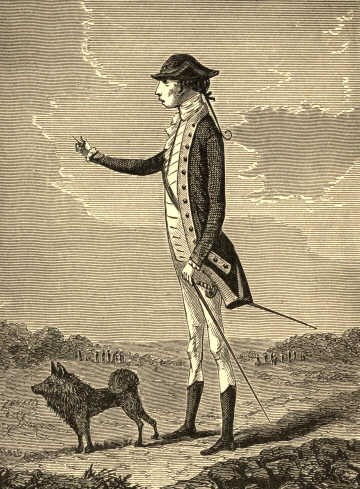
Charles Scribner's Sons
To defend Charleston, Lee had 6,500 troops, about half of them Continentals. Given command over Colonels Moultrie, Thomson, and their regiments, he hurriedly surveyed the Patriot defenses by boat and on horseback and issued directives. Nothing worried Lee more than the vulnerability of Moultrie's fort, which he deemed a flimsy palmetto “slaughter pen” for its defenders. He ordered construction of an escape bridge built of empty hogsheads across the Cove, an inlet that separated the island from the mainland. “Sir, when those ships come to lay alongside of your fort,” he warned Moultrie, “they will knock it down in half an hour.” He also had doubts about Moultrie himself. “For heaven’s sake, sir,” Lee told him, “everybody is well persuaded of your spirit and zeal, but they accuse you of being too easy in command….There is not a greater vice.” Privately John Rutledge, recently elected President of South Carolina, advised Moultrie, “General Lee wishes you to evacuate the fort. You will not without an order from me. I will sooner cut off my hand than write one.”
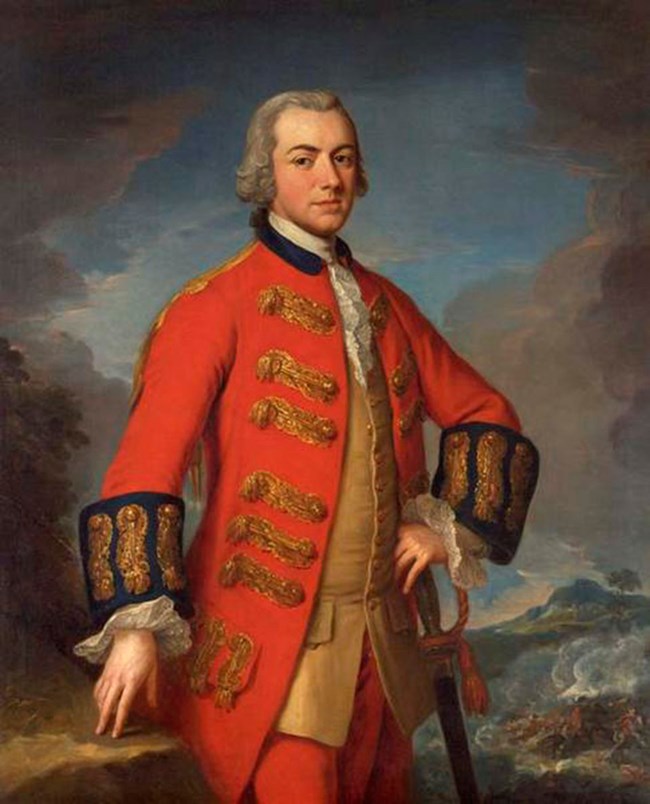
The American Museum in Britain
British Preparations
Meanwhile, the British faced their own hazards. Getting the ships across the bar required calm seas and precise navigation. As Parker struggled with his ships, British regulars landed on Long Island (today Isle of Palms). It had been “confidently reported by the pilots,” Clinton wrote, that at ebb tide the two islands were “joined by a ford passable on foot” across Breach Inlet. A closer inspection of Breach Inlet revealed a channel that even at low water was a hundred yards wide and seven feet deep, not the eighteen inches Clinton expected.
With the new intelligence, Clinton informed Parker that the army could merely attempt a demonstration against Thomson's men at Breach Inlet. No landing on the mainland was feasible because of impenetrable swamps, and while the inlet was too deep to wade, it was too shallow for any man-of-war to provide gunfire support. The squadron only possessed fifteen flat-bottomed assault boats, capable of transporting less than a quarter of Clinton’s force at one time to Sullivan’s Island. Such a fragmented attack, without adequate firepower, would easily be defeated in detail. Clinton also overestimated the size of the force opposing him under Col. Thomson.
Even without adequate support from Clinton's men, Parker decided to move on with plans to attack the fort. The honor of the Royal Navy was at stake. He believed the ferocity of the naval bombardment would cow the Americans into surrender. Confusion between the army and navy grew, worsened by the lack of personal contact between commanders. As the British postponed their attack for various reasons, the Americans watched and waited.
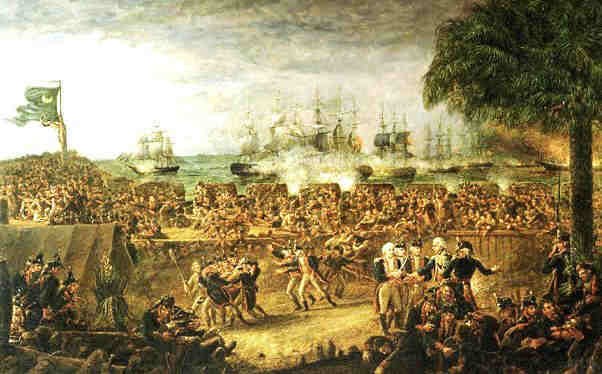
Wikimedia Commons
The Battle
Moultrie rode north on June 28 to inspect Thomson’s entrenchments at Breach Inlet. While discussing the defense of the island with Thomson, Moultrie heard a cry from a lookout in the dunes, warning that British ships were sailing towards the fort. Moultrie galloped back to the fort, shouting for his drummer to beat the long roll, summoning the garrison to their battle posts.
The bomb ketch Thunder was the first to fire, opening the British attack. Early in the bombardment, a British shell squarely struck the American magazine and failed to detonate. Under Parker’s battle plan, four frigates were to deliver the main bombardment – Bristol and Experiment, mounting fifty guns apiece, and Active and Solebay, each with twenty-eight. Local pilots assured Parker that his ships could close to within seventy yards of the parapets, near enough to rake the defenders with grapeshot. To Parker’s frustration, pilots studying the water refused to move the larger men-of-war closer than five hundred yards and nudged the smaller vessels only slightly nearer. The conduct of the pilots, local enslaved African Americans, remains a mystery. Did they commit errors or knowingly mislead the British?
The ferocity of the British naval bombardment had no great effect on the fort. Sabal palmetto trunks embedded in deep sand proved pliable and sturdy enough, absorbing iron balls like a sponge. Clinton, writing after the battle, argued "The Materials with which Fort Sullivan is constructed form no inconsiderable part of its strength. The Piemento (sic) Tree, of a spongy substance, is used in framing the Parapet & the interstices fill'd with sand. We have found by experience that this construction will resist the heaviest Fire."
General Clinton, meanwhile, launched his promised diversionary attack in the form of a flat-bottomed flotilla from Long Island. When the British attempted to force their way across, they made no progress against Thomson's riflemen and gunners firing from behind palmetto and earthen breastworks. A Charleston loyalist who had joined the British and served in the flotilla said that "it was impossible for any set of men to sustain so destructive a fire as the Americans poured in."
The failure of the Royal Navy's assault continued at the other end of Sullivan’s Island. Parker ordered three frigates – Actaeon, Sphinx, and Syren – to swing toward Rebellion Road, the anchorage within Charleston Harbor. They were to enfilade the fort with cross fire and disrupt any potential American retreat over the Cove to the mainland. Pilots on the warships, again through error or duplicity, ran their vessels aground on the Lower Middle Ground, the shoal where Fort Sumter was later built. Sphinx and Syren were saved, but the 28-gun Actaeon was stuck in the sand.
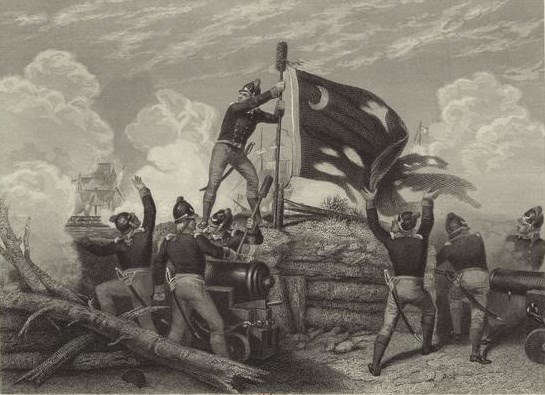
New York Public Library
Lee finally arrived at Moultrie's fort late in the afternoon to find the defenders “determined and cool to the last degree.” “Colonel,” Lee told Moultrie, “I see you are doing very well here, and you have no occasion for me.” Seven hundred pounds of extra powder were sent across the Cove with a note to Moultrie from John Rutledge: “Do not make too free with your cannon Cool and do mischief.”
Mischief was done, as the British could later attest. By early evening, all hope for a British victory had vanished. Parker's frigates fired some 7,000 rounds and burned more than 12 tons of powder – 220 barrels between Bristol and Experiment alone – compared to 960 shot and 4,766 pounds for the Americans. Yet overwhelmingly the damage fell hardest on the king’s ships.
Bristol, struck seventy times, suffered the most damage. “We are in a shattered condition,” an officer wrote. “No slaughterhouse could present so bad a sight, with blood and entrails lying about, as our ship did.” Every man serving on the quarterdeck was killed or wounded, among the 111 casualties throughout the ship, 40 of them were dead. Commodore Sir Peter Parker's breeches were literally blown away, leaving his buttocks bare. Governor William Campbell, the deposed royal governor of South Carolina, who volunteered to fight on the lower gun deck as if he were again a midshipman, took a painful splinter in the left side that contributed to his death in England two years later.
In the evening, with June’s long light fading, his ammunition dwindling, the tide ebbing, and his ships severely damaged, Parker signaled for the squadron to withdraw to their earlier moorings in Five-Fathom Hole. Actaeon, marooned on her sandbar, was beyond salvage. Captain Atkins received permission from Parker to abandon ship and set the frigate ablaze.
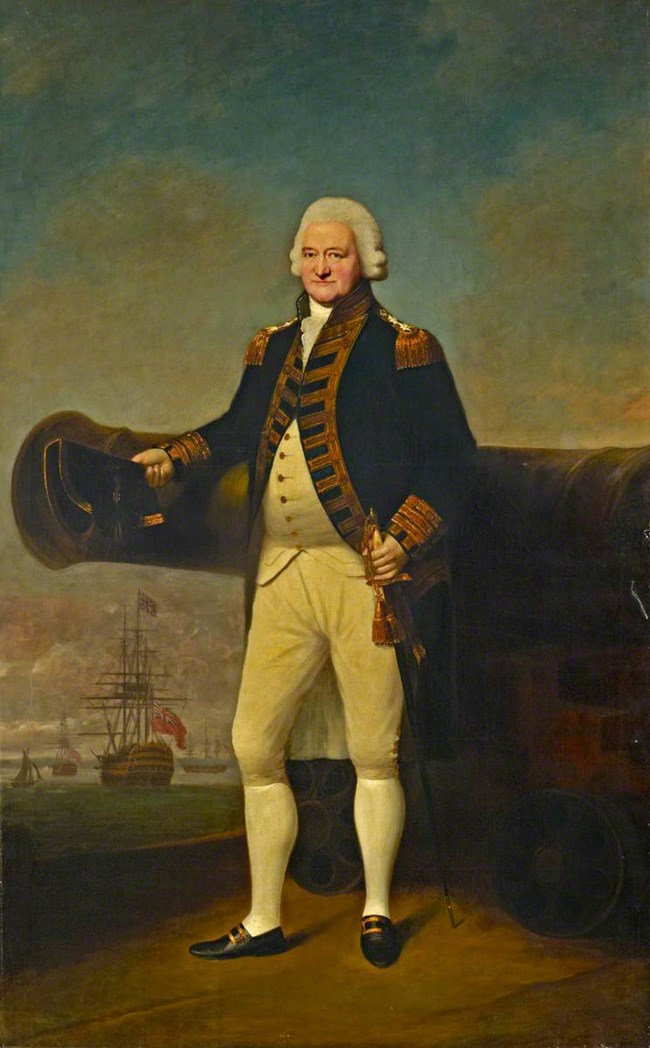
National Maritime Museum, Greenwich
Reaction to the Patriot Victory
“We never had such a drubbing in our lives,” a Royal Navy sailor wrote. British battle casualties exceeded 200; damage to British morale was also devastating. “This will not be believed when it is first reported in England,” a British naval surgeon predicted. Both Parker and Clinton hurriedly wrote their respective dispatches, the better to influence what London might believe. Parker’s account to the Admiralty omitted Clinton’s offer of a diversionary attack and other relevant details. “If the troops would have cooperated on this attack…His Majesty would have been in possession of Sullivan’s Island,” he wrote, but “I was satisfied that the landing was impracticable” and would have resulted in “the destruction of many brave men without the least probability of success.”
For the Americans, losses from the ten-hour battle totaled 26 wounded and 12 killed. Lee believed, as he wrote Washington, that “the dilatoriness and stupidity of the enemy saved us.” If the three flanking frigates had not run aground, the fort would surely have faced devastating fire. British officers grappled for their own explanations. Captain Lord Rawdon, the deputy adjutant general, concluded that “a long train of little accidents has entirely frustrated every purpose of this expedition.” Many were convinced, as Captain James Murray of the 57th Foot wrote, that misreading the depth of Breach Inlet was “the fatal source of all our misfortunes.” Yet even had the shallow ford existed, regulars would have been forced to wade across a broad swath of exposed water against entrenched defenders. Miscalculation and misjudgment derailed the expedition from conception to conclusion, including Clinton’s agreement with Parker at Cape Fear to attack Charleston, against his better instincts.
General Washington's general orders of July 21 shared the news of the victory at Sullivan's Island with his men defending New York, writing that
"This glorious Example of our Troops, under the like Circumstances with us, The General hopes will animate every officer, and soldier, to imitate, and even out do them, when the enemy shall make the same attempt on us: With such a bright example before us, of what can be done by brave and spirited men, fighting in defence of their Country; we shall be loaded with a double share of Shame, and Infamy, if we do not acquit ourselves with Courage, or a determined Resolution to conquer or die: With this hope and confidence, and that this Army will have its equal share of Honour, and Success....With such preparation, and a suitable Spirit, there can be no doubt, but by the blessing of Heaven, we shall repel our cruel Invaders; preserve our Country, and gain the greatest Honor.”
